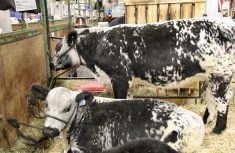Ontario’s feedlot sector is currently facing a number of threats, but some positive signals from a younger generation and producer-led marketing initiatives hold the promise of a more robust future.
“A lack of slaughter capacity is limiting growth,” said Jack Chaffe. “We’re maxed out with so many new barns built and so many cattle on feed.”
Chaffe finishes about 3,000 head of cattle annually at his operation north of Mitchell. He’s a fourth generation producer who’s also vice-president of the Ontario Cattle Feeders’ Association and a board member of the Beef Farmers of Ontario.
Read Also

Body condition, nutrition and vaccination for brood cows
One of the remarkable events of the past century related to ranching has been the genetic evolution of brood cows….
Marketing a bright spot
The Ontario Corn-Fed Beef (OCFB) program is a bright spot for the future, but its growth, too, might be limited by slaughter capacity.
“We have to figure out how to get more cattle slaughtered — whether here in Ontario, south of the border, or somewhere else,” he said.
The marketing and branding program has been in place for nearly 20 years, and producers like Chaffe who participate have to adhere to strict quality assurance protocols. These include feeding, environmental, animal welfare and other practices that, when combined, produce a tender, juicy and flavourful product. The program continues to be a success, getting Ontario beef products into big domestic grocery chains such as Loblaws and into export markets such as Japan.
Chaffe said the beef industry in general is suffering from having huge investments and very little payoff in terms of returns. As well, an entire generation of beef producers was lost to the discovery of bovine spongiform encephalopathy (BSE) in 2003.
“But the younger generation is showing an interest and wanting to get in,” he said. To maintain that enthusiasm, new technology needs to be developed in, for example, barns, handling facilities and feeding programs, he added.
He referenced Cactus feeders, which are currently being used by eight to 10 feedlots in Ontario — including his. These feed systems use DNA sampling to determine the optimum time for cattle to be marketed.
Regulatory issues
Government regulations and policy decisions also hinder the Ontario feedlot industry. The province’s recent increase in the required amount of ethanol in gasoline to 10 per cent from five per cent by 2020 will only exacerbate an already tough situation for beef producers looking to rent or buy land.
Since 2004, when the regulations were initially put into place, producers took a lot of land out of pasture and planted it into grains and oilseeds. Land prices skyrocketed, and the Ontario beef herd shrank by a third between 2005 and 2015.
“Government doesn’t get it — when they support one industry, sometimes they harm another,” Chaffe said.
New federal transportation regulations being implemented in February next year will also cause a lot of pain to Ontario feedlot operators, who ship 350,000 to 370,000 cattle from the west every year. The maximum amount of time cattle spend in transport will be reduced to 36 hours from 48 hours. At that point, there will be an eight-hour rest period during which the cattle have to be fed and watered.
Chaffe said that, currently, cattle can be trucked straight from Moose Jaw, Sask., to Ontario. When the regulations kick in, there will be a dividing line around Winnipeg where any cattle being shipped from west of there will have to stop in Thunder Bay. He contends that there isn’t enough capacity at current rest stops to accommodate all the cattle being shipped.
“If the government wants to put new regulations on us, we need to have compensation so new facilities can be erected in northern Ontario to feed and water the cattle,” he said.
New directions
A new marketing initiative fuelled by a $1.50 increase in the check-off recently voted in by the Beef Farmers of Ontario (BFO) is another opportunity.
“We’re hoping to drive more capacity by growing the demand for consumers to buy local product,” Chaffe said.
While the program is still in the preliminary stages of development, the idea is that by boosting the level of marketing, consumers will better recognize and buy Ontario beef, and that pull will work through the supply chain. It will be run by a joint committee of the Beef Farmers of Ontario and the Ontario Cattle Feeders Association. Jim Clark, head of the successful OCFB program, is leading the initiative.
There has already been some success with this approach. CARVE is a new brand of premium Ontario beef introduced by Flanagan’s Foods in 2017. In its first year, the company made $3 million in sales.
The idea is that the more products that get into grocery carts, the more feedlot operators will need to supply processors, and the more they’ll be shopping for feeder cattle, which will push the prices up.
“The bigger the brand, the more beef you move, and the quicker it makes a difference.”
Another opportunity Chaffe sees is for cow-calf producers to get cattle grouped into larger lots and have them backgrounded in Ontario before finishing. If they kept ownership to that stage, they would make more money.
“There needs to be more guys in the backgrounding end of the industry,” he said. “We want bigger groups so we can finish the last 100 to 150 days.”
Cow-calf operators can also get better prices by improving their genetics. A study published last year found genetic markers that may help improve selection for feed efficiency in beef cattle. The research was conducted at the University of Guelph’s Livestock Research Innovation Centre in Elora and funded by the federal and provincial governments, along with a number of commodity groups and private companies.
The preliminary results are promising, and work is under way to validate the results across purebred and crossbred beef cattle using different management methods.
“If the genetics are better, the performance is better, and you can pay more for the cattle,” Chaffe said.
While Ontario’s feedlot industry problems continue to be many and difficult, overcoming them through technology, genetics, good marketing and an enthusiastic younger generation may be just the ticket to a more successful future.
— Lois Harris is an experienced Ontario freelance writer and editor working in the agriculture and food industry.

















